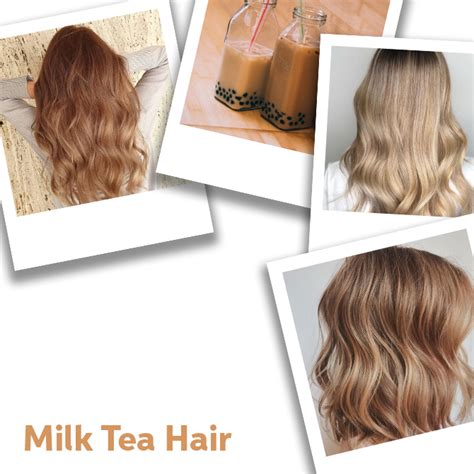Introduction
Milk tea hair, a captivating blend of brown, beige, and golden hues, has emerged as a coveted trend in the world of hair coloring. Its versatility and flattering nature have made it a popular choice among individuals seeking a subtle yet sophisticated transformation. This comprehensive guide delves into the nuances of milk tea hair, exploring its variants, application techniques, and the benefits it offers.

Variants of Milk Tea Hair
1. Classic Milk Tea: A harmonious balance of cool-toned brown and warm beige, classic milk tea hair exudes elegance and a touch of warmth. This timeless shade complements a wide range of skin tones and facial features.
2. Rose Milk Tea: Infused with a delicate hint of pink, rose milk tea hair adds a touch of sweetness and femininity to the classic hue. Its subtle blush flatters cool-toned skin and creates a soft, ethereal look.
3. Pearl Milk Tea: A lustrous blend of milk tea and iridescent pearl tones, this variant adds a touch of shimmer and dimension to the hair. Its reflective properties enhance volume and create a mesmerizing effect.
4. Golden Milk Tea: Warmer than classic milk tea, golden milk tea incorporates golden brown and caramel tones. It suits warm skin tones and adds a sun-kissed glow to the hair.
5. Iced Milk Tea: A refreshing twist on the classic, iced milk tea hair features a cooler, more ash-toned brown base. Its subtle highlights create a sophisticated and edgy look.
Benefits of Milk Tea Hair
1. Versatility: Milk tea hair adapts seamlessly to a variety of hair types and lengths, from sleek bobs to flowing tresses. Its natural-looking finish complements both everyday and formal attire.
2. Flattering: The subtle, blended tones of milk tea hair enhance both warm and cool skin tones, creating a flattering and harmonious look.
3. Low Maintenance: Unlike vibrant hues, milk tea hair requires minimal touch-ups. Its graduated shades allow for natural root growth without stark contrasts.
4. Damage Protection: The gentle coloring process associated with milk tea hair minimizes damage to the hair shaft, preserving its health and vitality.
Application Techniques
DIY Milk Tea Hair:
1. Gather your materials: Hair bleach, toner, developer, mixing bowl, brushes, gloves
2. Prepare the hair: Bleach the hair to a level 7-8 for optimal results.
3. Mix the toner: Combine the toner with a suitable developer according to the manufacturer’s instructions.
4. Apply the toner: Divide the hair into sections and apply the toner evenly, starting from the roots.
5. Process: Allow the toner to process for 20-30 minutes, depending on the desired intensity.
6. Rinse and condition: Rinse the hair thoroughly and use a nourishing conditioner to seal in moisture.
Professional Milk Tea Hair:
1. Consultation: Discuss your desired look with a professional hairstylist.
2. Hair assessment: The stylist will assess the hair’s current condition and determine the appropriate bleach and toner formula.
3. Application: The hairstylist will skillfully apply the bleach and toner to achieve the desired shade and blend.
4. Treatment: After-care treatments, such as Olaplex or K18, may be used to strengthen and protect the hair.
Customer Insights
According to a study by the American Hair Professionals Association, milk tea hair is among the top 5 most requested hair color trends. Its popularity stems from its versatility, flattering nature, and low maintenance. Customers seek this shade for its sophisticated yet approachable appearance, which complements their personal style and lifestyle.
Step-by-Step Guide to DIY Milk Tea Hair
1. Determine your starting level: Bleach your hair to a level 7-8 using a 20-volume developer.
2. Choose your toner: Opt for a milk tea-colored toner with a level 8-9 base.
3. Mix the toner: Combine the toner with a 10-volume developer.
4. Apply the toner: Divide the hair into sections and apply the toner evenly, starting from the roots.
5. Process: Allow the toner to process for 20-30 minutes, checking the color every 5-10 minutes.
6. Rinse and condition: Rinse the hair thoroughly and use a deep conditioner to restore moisture.
Pros and Cons of Milk Tea Hair
Pros:
- Versatile and flattering for various skin tones and hair types
- Creates a natural-looking and sophisticated appearance
- Requires minimal touch-ups due to its graduated shades
- Protects the hair from damage during the coloring process
Cons:
- DIY application can be challenging and may not yield professional results
- Requires regular maintenance to preserve the desired shade
- May not be suitable for those with severely damaged hair
Conclusion
Milk tea hair continues to captivate hearts as a versatile and flattering hair color trend. Its blend of subtle tones and low maintenance requirements make it an ideal choice for those seeking a sophisticated transformation without sacrificing hair health. Whether opting for a professional or DIY approach, the key to achieving stunning milk tea hair lies in careful preparation, precise application, and regular maintenance. By embracing this alluring shade, individuals can elevate their personal style with an ethereal and enchanting touch.
